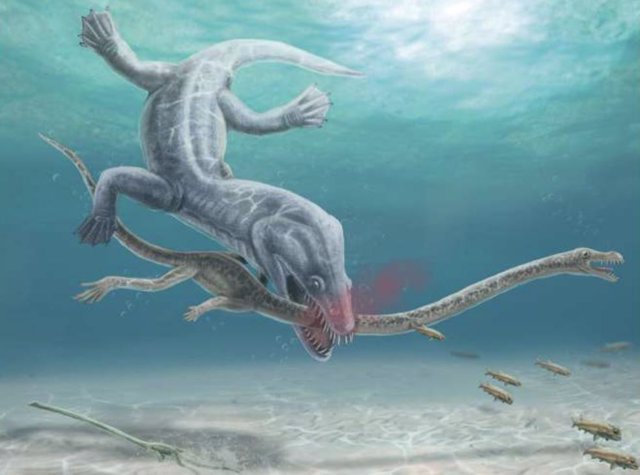
June 19 () –
direct fossil evidence has confirmed for the first time how vulnerable many marine reptiles with extremely long necks were compared to those of today.
A research published in Current Biology studied the unusual necks of two Triassic species of Tanystropheus, a type of reptile distantly related to crocodiles, birds, and dinosaurs. The species had unique necks made up of 13 extremely elongated vertebrae and strut-like ribs. Consequently, these marine reptiles likely possessed stiff necks and waited to ambush their prey. But Tanystropheus’s predators apparently also took advantage of the long neck for their own benefit.
Careful examination of their fossilized bones now shows that the necks of two extant specimens representing different species with severed necks have clear bite marks, in one case just where the neck was broken. The findings offer gruesome and extremely rare evidence of predator-prey interactions in the fossil record dating back more than 240 million yearssay the researchers.
“Paleontologists speculated that these long necks formed an obvious weak point for predation, as already vividly depicted almost 200 years ago in a famous painting by Henry de la Beche from 1830,” said Stephan Spiekman of the Staatliches Museum für Naturkunde Stuttgart, Germany. . “However, there was no evidence of beheading, or any other type of attack directed at the neckknown from the abundant fossil record of long-necked marine reptiles up to our present study on these two Tanystropheus specimens.”
Spiekman had studied these reptiles as the main subject of his doctoral work at the Palaeontological Museum of the University of Zurich, Switzerland, where the specimens are housed. He recognized that two species of Tanystropheus lived in the same environment, a small species, about five feet long, probably feeding on soft-shelled animals such as shrimp, and a much larger species up to twenty feet long. who ate fish and squid. He also found clear evidence in the shape of the skull that Tanystropheus probably spent most of his time in the water.
It was well known that two specimens of these species had well-preserved heads and necks that ended abruptly. It had been speculated that these necks were bitten off.but no one had studied this in detail.
On the new study, Spiekman teamed up with Eudald Mujal, also from the Stuttgart Museum and associate researcher at the Institut Català de Paleontologia Miquel Crusafont, an expert in fossil preservation and predator interactions in the fossil record based on bite marks in bones. After spending an afternoon examining the two specimens in Zurich, they concluded that the necks had clearly been bitten off.
“Something that caught our attention is that the preserved skull and part of the neck have not been altered, they only show some disarticulation due to the typical decomposition of a corpse in a calm environment,” Mujal said. “Only the neck and head remain, there is no evidence whatsoever for the rest of the animals. Necks end abruptlyindicating that they were completely cut down by another animal during a particularly violent event, as evidenced by the presence of tooth imprints.”
“The fact that the head and neck are so intact suggests that when they arrived at their final burial site, the bones were still covered by soft tissue such as muscle and skin,” Mujal continued. “Clearly, the predator did not feed them. Although this is speculative, it would make sense that predators would be less interested in the thin neck and small head, and instead concentrate on the much meatier parts of the body. Taken together, these factors make it more likely that both individuals have been decapitated during the hunt and have not been scavengers, although carrion can never be completely excluded in fossils that are that old.”
“Interestingly, the same scenario, although certainly executed by different predators, played out for both specimens, which, reminiscent, represent individuals of two different species of Tanystropheus, that are very different in size and possibly lifestyleSpiekman says.
The findings confirm previous interpretations that the necks of ancient reptiles represent an entirely unique evolutionary structure that was much narrower and more rigid than those of long-necked plesiosaurs, according to the researchers. They also show that the evolution of a long neck as a marine reptile had potential downsides. However, they point out, elongated necks were clearly a very successful evolutionary strategy, which was found in many different marine reptiles over a period of 175 million years.


![[Img #74674]](https://thelatestnews.world/wp-content/uploads/2024/12/Santiago-Ramon-y-Cajal-The-promoter-of-modern-neuroscience-150x150.jpg)









![[Img #74674]](https://thelatestnews.world/wp-content/uploads/2024/12/Santiago-Ramon-y-Cajal-The-promoter-of-modern-neuroscience-300x200.jpg)

